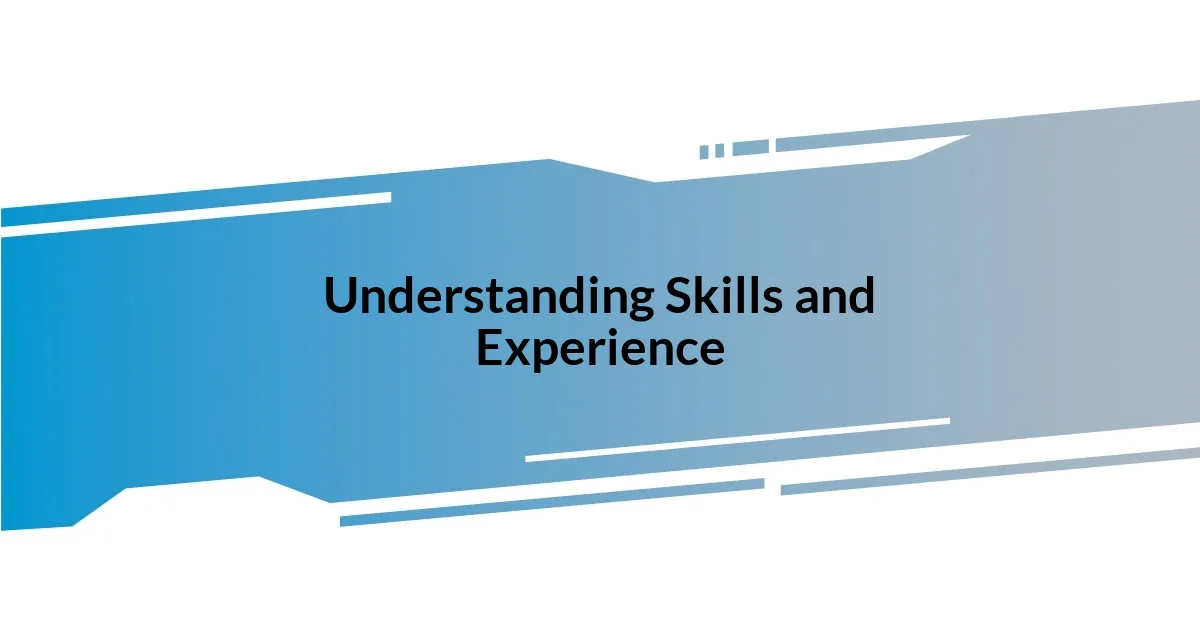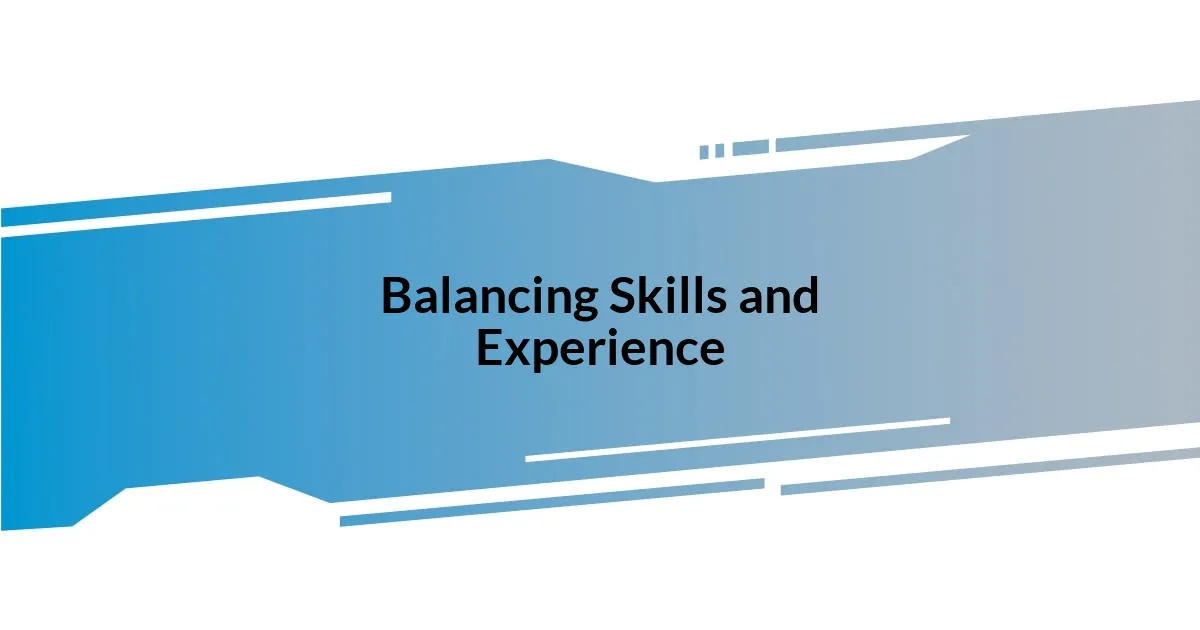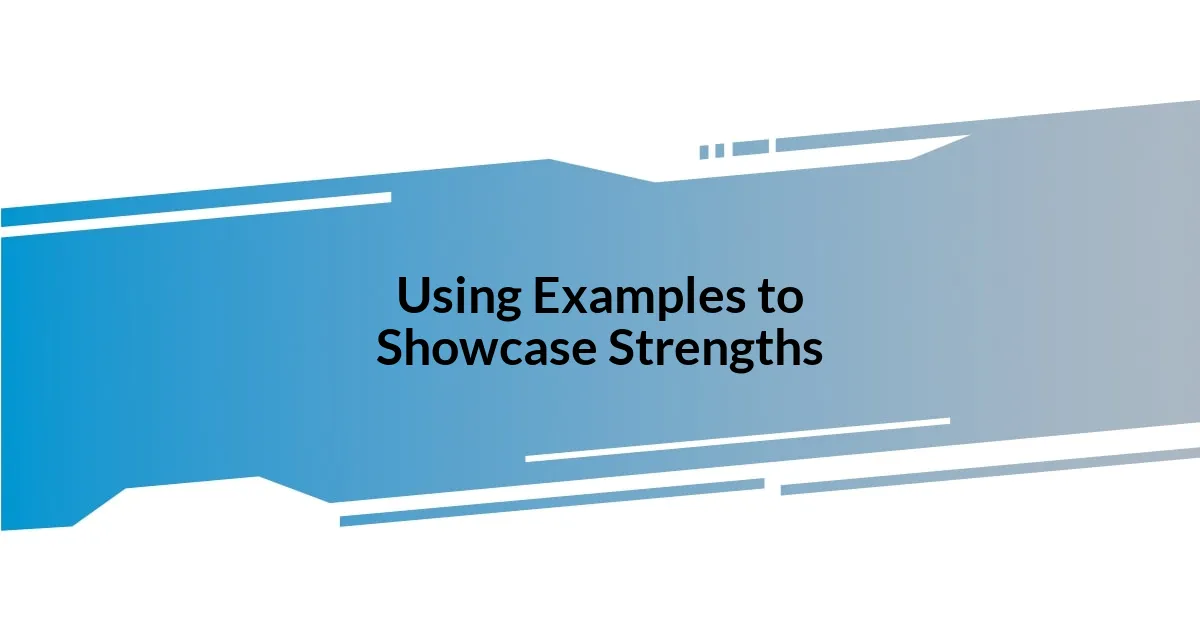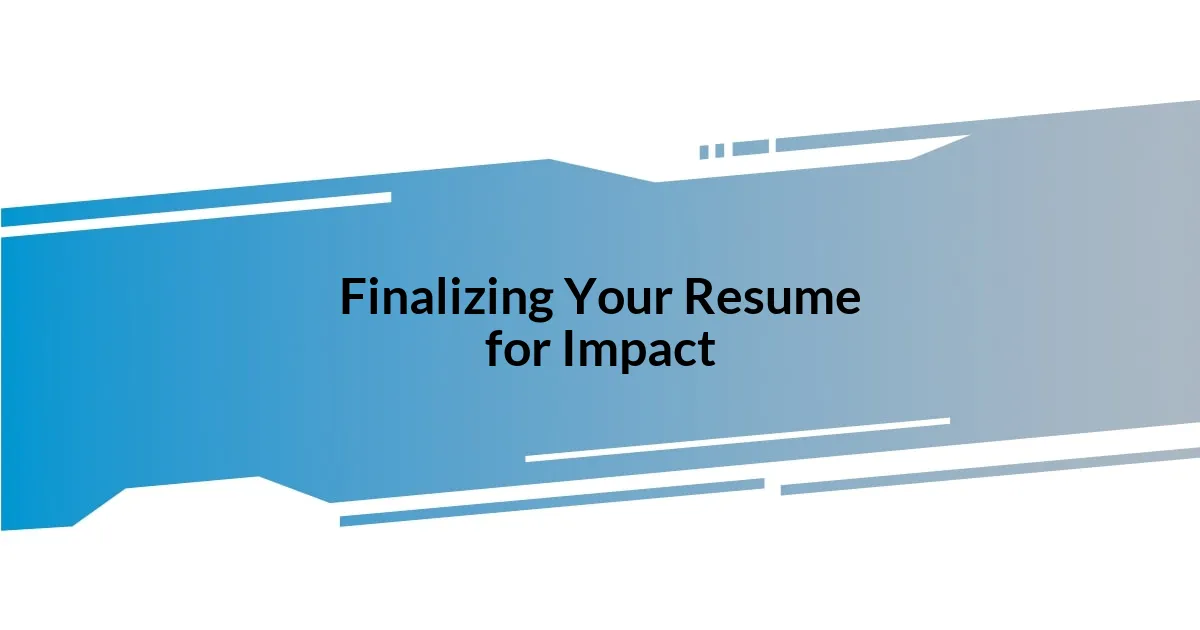Key takeaways:
- Understanding the difference between skills (abilities) and experience (practical application) is essential for crafting an effective resume.
- Customizing resumes for specific job applications enhances relevance, connection, and focus, increasing the chances of standing out to hiring managers.
- Using concrete examples and storytelling improves the impact of presenting skills and experiences, making them more relatable and memorable.
- Finalizing a resume involves careful curation, ensuring clarity, consistency, and alignment with company culture to create a lasting impression.

Understanding Skills and Experience
Understanding the distinction between skills and experience is crucial in crafting an effective resume. Skills are the specific abilities or proficiencies I’ve developed, like coding in Python or mastering public speaking. Experience, on the other hand, refers to the practical application of those skills, shaped by the environments I’ve worked in and the challenges I’ve faced.
When I first started my career, I struggled to showcase both elements effectively. I remember having a conversation with a mentor who emphasized that simply stating my ability to write well wasn’t enough; I needed to illustrate how I had used that skill to deliver impactful presentations to clients. It made me realize that by sharing detailed accounts of my experiences, I could paint a clearer picture of my capabilities. Have you ever felt that your skills didn’t shine through in your job applications?
Combining skills and experience creates a powerful narrative. For instance, when I listed my project management skills, I shared how I successfully led a team through a critical deadline under pressure. This combination not only highlighted my skills but also brought my unique experience to the forefront. I found that this approach resonated with hiring managers, opening doors to conversations I hadn’t anticipated.

Importance of Tailored Resumes
Tailoring my resume to fit specific job applications has made a world of difference in how I present myself to potential employers. I’ve learned that hiring managers often sift through numerous applications, and a generic resume can easily get lost in the shuffle. By focusing on the job description and aligning my skills and experiences to their needs, I create a compelling narrative that stands out.
Here are some key reasons why tailored resumes are vital:
- Relevance: Highlighting skills that are specifically requested in a job listing shows that I’m paying attention and value the employer’s needs.
- Connection: Sharing targeted experiences helps create an emotional connection between my background and the company’s goals.
- Clear Focus: A tailored resume provides clarity, making it easier for hiring managers to see why I’m a great fit for the role.
I vividly remember applying for a marketing position where I customized my resume to emphasize my social media strategy success. I not only listed my skills but also shared specific metrics, like a 30% increase in engagement rates from a particular campaign I led. When I received a callback, I couldn’t help but feel a rush of exhilaration; it was proof that my tailored approach had made an impact.

Identifying Relevant Skills for Jobs
Identifying the relevant skills for a job starts with a deep dive into the job description itself. I’ve found it incredibly beneficial to highlight the keywords and phrases that stand out. For instance, if a job posting emphasizes teamwork and problem-solving, I focus on those aspects in my own skill set. It may seem a bit tedious, but let me tell you, sifting through those descriptions has consistently led me to tailor my resume effectively.
During my own job search, I encountered a position that required strong analytical skills. Instead of just listing “analytical skills,” I detailed how I improved client data tracking systems, which ultimately saved time and reduced errors. That experience not only showcased my skills but also illustrated my ability to deliver results. Don’t you think it’s more impactful when you can back up a skill with a concrete example? It transformed my resume from a simple list into a narrative of my professional journey.
To help contextualize the skills and experiences that align with job requirements, I’ve created the following comparison table. It illustrates how I identified relevant skills based on specific job descriptions:
| Job Requirement | Relevant Skill |
|---|---|
| Strong Leadership | Led cross-functional teams in multiple projects achieving 20% faster delivery |
| Analytical Thinking | Improved data tracking leading to a 30% reduction in errors |
| Excellent Communication | Developed and presented monthly reports to management, enhancing decision-making |

Highlighting Experience Effectively
When it comes to highlighting experience, I believe specificity is key. I remember one time, I was applying for a project management role. Instead of merely stating I had “experience managing projects,” I detailed my role in a marketing campaign where I led a team of five to launch a product in three months, ultimately exceeding sales targets by 25%. Doesn’t it feel more convincing when you share the exact impact of your work? By weaving in these details, I transformed a bland resume into a vivid snapshot of my contributions.
Effective storytelling goes a long way, too. I’ve found that sharing challenges faced during my work and how I overcame them makes my experience relatable. For instance, recounting how I managed a tight budget while successfully executing an event resonated with interviewers. They could visualize the problem and appreciate the solution I provided. Isn’t it fascinating how a few well-chosen words can bring our experiences to life in someone else’s mind?
Another strategy I’ve adopted is using bullet points to break down experiences into digestible bites. When detailing my role at a tech company, I structured it like this: “• Led a team of developers in launching an app • Increased user feedback scores by 40% • Streamlined the testing process, reducing time by 15%.” This not only improves readability but highlights key achievements at a glance. Don’t you find it easier to grasp information when it’s organized this way? By adopting this approach, I’ve seen my resume transform into a powerful tool for storytelling.

Balancing Skills and Experience
Balancing skills and experience in my resume has always felt like walking a tightrope. I recall a time when I was torn between showcasing my technical skills and my hands-on experience. Ultimately, I discovered that blending the two offered a more compelling picture of who I am as a professional. For example, when I mentioned my coding proficiency, I paired it with a project where I developed a tool that improved team efficiency by 15%. Doesn’t it strike you how merging skills and experience can create a powerful narrative?
Sometimes, I struggled to find the right balance between claiming expertise and demonstrating it. I remember applying for a customer service manager position; while I had extensive experience leading teams, I needed to highlight my conflict-resolution skills too. So, I decided to share a story about a time when I turned a dissatisfied client into a loyal one. By detailing the steps I took to manage a tough situation, I showcased not only my soft skills but also my ability to handle real-life challenges. How often do we overlook the significance of such anecdotes in strengthening our resumes?
As I refined my resume, I realized that less can be more. Initially, I tried to pack everything into one document, thinking it would impress employers. But then I learned the art of prioritization. Focusing on the skills and experiences most relevant to each specific job allowed me to craft tailored narratives that spoke directly to hiring managers. With each targeted application, I saw positive responses increase. Have you ever noticed how tailoring your message can yield better results? It’s a lesson that has changed my approach to job applications entirely.

Using Examples to Showcase Strengths
When I look back at my resume-writing journey, one moment stands out: sharing a specific triumph in my previous role. There was a time I instituted a new training program that resulted in a 30% increase in team productivity. Rather than just stating this achievement, I described the struggles we faced initially and how the new training method reshaped our work culture. Isn’t it remarkable how you can turn a mere statistic into a story that resonates with potential employers?
One technique that served me well was including tangible results from projects I led. I vividly remember explaining how I streamlined a workflow that reduced project delivery time by two weeks. I didn’t just list the achievement; I dove into the thought process behind the change and the team’s response, which made it feel alive. This storytelling approach not only impressed hiring managers but also gave them a glimpse into my problem-solving skills and the impact I can make. Have you considered how much more impactful your experiences might be when you paint a complete picture?
Additionally, I’ve learned the importance of weaving in personal reflections. After presenting a project pitch that helped us land a significant client, I expressed how the thrill of that achievement pushed me to seek out more challenging opportunities. This emotional connection not only showcased my enthusiasm but also helped to connect with the reader on a human level. It makes me wonder, how can we invite hiring teams into our personal journeys without overwhelming them? By sharing these insights, I’ve transformed dry bullet points into narratives that genuinely reflect who I am.

Finalizing Your Resume for Impact
Finalizing your resume is where curation meets impact. As I sat down to give my final touches, I sifted through every bullet point, asking myself if each item painted a vivid picture of my professional journey. I remember deleting a few lines that simply listed duties; instead, I focused on accomplishments that brought my achievements to life. How often do we realize that it’s not just about what we’ve done, but how it resonates with the reader?
There’s something powerful about striking the right tone. I vividly recall refining the language of my resume to match the culture of the companies I was applying to. For instance, for a tech startup, I used dynamic, action-oriented verbs that conveyed my excitement and adaptability. That tweak changed my resume from a static document into a reflection of my energy and enthusiasm. Isn’t it amazing how a few word choices can turn a resume from ordinary to memorable?
In my final sweep, I realized the significance of clarity and consistency. Aligning my formatting and style was crucial; after all, an organized resume presents a well-structured professional. I distinctly remember feeling a sense of relief when I perfected the layout—identifying that clear headings and consistent fonts made my resume not just appealing but also easy to navigate. So, ask yourself: does your resume look as polished as your experience deserves? By ensuring every detail is intentional, I created a lasting impression—one worth the effort.
